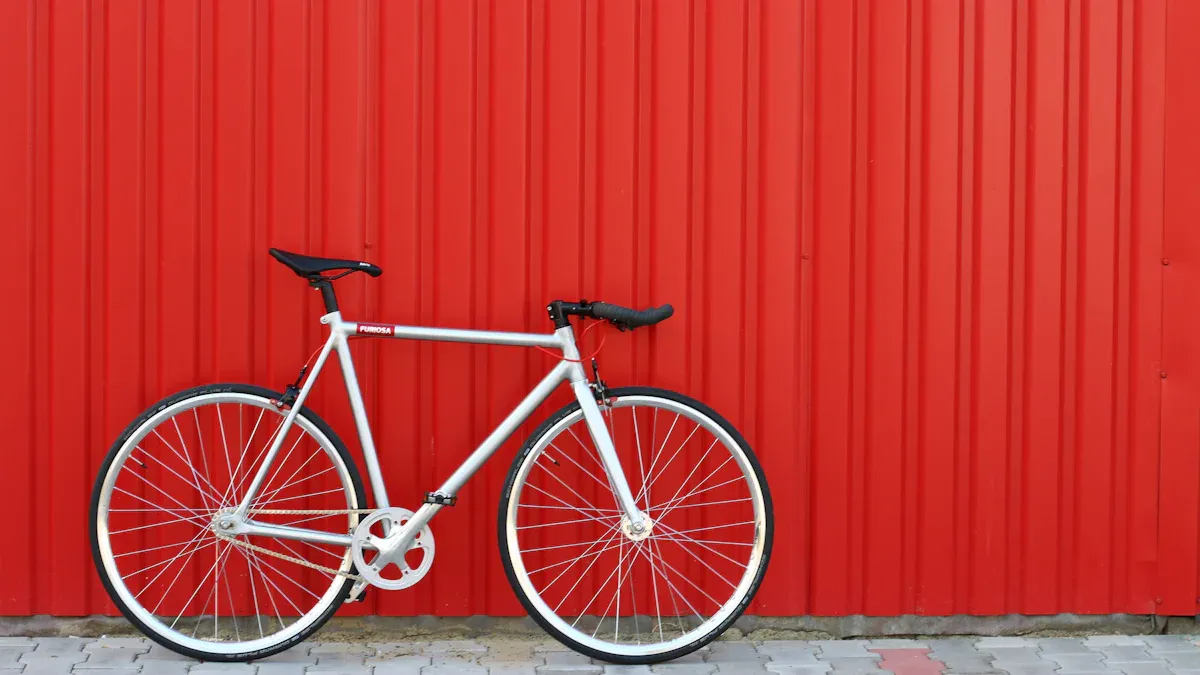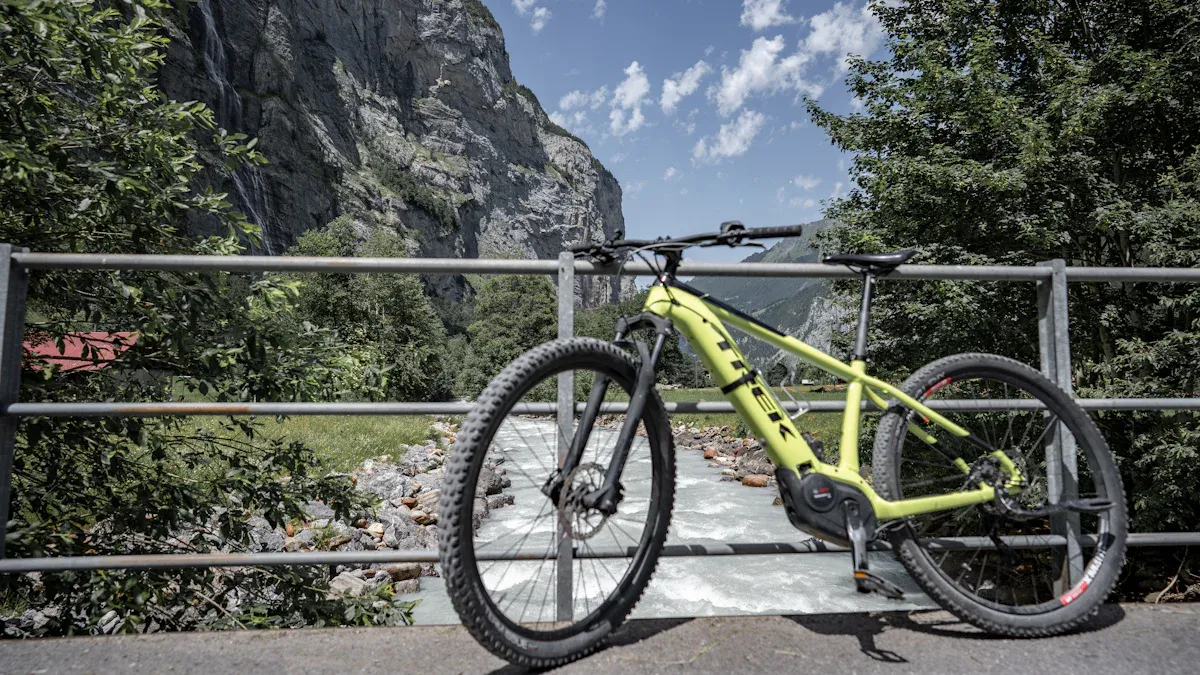
Magnesium bike frames are strong and light. They are lighter than many other materials. Magnesium has a density of only 1.74 g/cm³. This makes magnesium frames lighter than aluminum or steel frames. Riders often feel more comfortable on these bikes. They also find it easier to control the bike. Many cyclists say their rides are smoother. They notice better shock absorption with magnesium frames. Some important features are:
Magnesium bike frames soak up vibrations well. This helps cut down on shocks and road bumps.
New magnesium alloys last longer and resist rust better.
Magnesium is light, so cyclists can ride farther with less work.
Key Takeaways
Magnesium bike frames are light and strong. This makes rides smoother. It also makes bikes easier to control. They absorb bumps better than aluminum frames. They also absorb vibrations better than carbon fiber frames. This helps riders feel less tired. Magnesium frames need special coatings. They also need regular care to stop rust. This helps them last longer. Magnesium is different from steel and titanium. It is also different from carbon fiber. Magnesium gives a good mix of comfort and weight. It also costs less. Magnesium is eco-friendly. It uses less energy to make. It can be recycled fully. This helps protect the environment.
Magnesium Bike Frame Comparison

Aluminum vs. Magnesium Bike Frames
Magnesium bike frames are very light. Magnesium has a density of about 1.74 g/cm³. Aluminum alloys like 6061-T6 and 7005-T6 are heavier. Their densities are around 2.7-2.78 g/cm³. So, magnesium frames weigh less than aluminum ones. Riders say magnesium frames are easier to lift and move.
Material | Density (kg/m³) | Yield Strength (MPa) | Tensile Strength (MPa) |
|---|---|---|---|
~1740 | Comparable | Comparable | |
Aluminum 6061-T6 | ~2700 | 193-290 | 241-320 |
Aluminum 7005-T6 | ~2780 | 290 | 350 |
Magnesium frames soak up bumps better than aluminum. Many riders think the ride feels smoother. Magnesium can reduce vibrations much more than aluminum. This helps riders feel less tired on long trips. Aluminum frames are strong and not too expensive. But they feel stiffer and less comfy. Magnesium frames are easier to fix but need more care to stop rust. Aluminum does not rust as easily, so it is good for people who want less work.
Tip: Magnesium bike frames are strong and comfy, but you must protect them from rust.
Steel vs. Magnesium Bike Frames
Steel frames have been used for a long time. They are tough and have a classic feel. But steel is much heavier than magnesium. Magnesium frames are lighter but still strong. People who switch from steel to magnesium notice the lighter weight right away.
Magnesium has a better strength-to-weight ratio than steel. This means you get a strong frame without extra weight. New magnesium alloys and coatings help stop rust. This makes them last longer than old magnesium frames.
Steel frames: heavy, very tough, classic ride
Magnesium frames: light, strong, better at stopping rust
Titanium vs. Magnesium Bike Frames
Titanium frames are known for being strong, light, and not rusting. Many people think titanium is the best for fancy bikes. Magnesium frames can be even lighter than titanium. Sometimes, a magnesium frame is almost two pounds lighter.
The price for titanium and magnesium frames can be close. Some people build magnesium bikes for about the same price as titanium ones. Both give a smooth ride, but magnesium soaks up bumps better. Titanium lasts a long time and does not rust. Magnesium needs a coating to stop rust.
Note: Magnesium bike frames are light and comfy like titanium, but they need more care.
Carbon Fiber vs. Magnesium Bike Frames
Carbon fiber frames are very strong and light. They are very stiff, which helps you pedal hard. Magnesium frames are also light but bend a little more. This makes the ride softer and more comfy, especially on bumpy roads.
Property | Carbon Fiber Frames | Magnesium Alloy Frames |
|---|---|---|
Very stiff, great for pedaling | Medium stiffness, bends a bit | |
Customization | Stiffness can be changed | Stiffness is more even |
Vibration Absorption | Not great, can feel rough | Soaks up bumps, smoother ride |
Impact Response | Dents or bends before breaking | Can break suddenly if damaged |
Corrosion Resistance | Does not rust | Needs a coating to stop rust |
Brittleness | Can break if hit hard | Bends but not as tough |
Magnesium frames can rust and get tired over time. They need special coatings and careful fixing. Carbon fiber does not rust but can crack if hit hard. Both are hard to fix, but magnesium needs special welding.
Magnesium bike frames are good for comfort and soaking up bumps. Carbon fiber is best for stiffness and strong pedaling.
Magnesium Alloy Frames: Material Properties

Strength-to-Weight Ratio
Magnesium alloy frames are strong but not heavy. They use alloys like AZ91, AM60, and ZK60. These alloys are lighter than aluminum and steel. This makes bikes easier to carry and ride. Riders get tired less quickly. Magnesium alloy has aluminum and zinc in it. These help make the frame strong and tough. AZ91 is easy to shape and does not rust fast. AM60 is strong and can bend without breaking. ZK60 is good at handling lots of use. It works well for light bike frames. Magnesium alloy frames stay strong but do not add much weight.
Magnesium alloys weigh less than aluminum and steel.
Lighter frames help riders steer and ride better.
Magnesium alloy frames are light and strong at the same time.
Density and Rigidity
Magnesium alloy is very light at 1.74 g/cm³. This makes bike frames lighter than most others. Riders can go faster and feel less tired. WE43 alloy is very stiff and keeps its shape. It has a Young’s modulus of about 45 GPa. This means it does not bend easily. Special ways of making the frame can change how stiff it is. Laser beam powder bed fusion is one way to do this. The hatch strategy makes the frame stronger. It creates small parts inside that help the frame. Magnesium alloy frames that are stiff give better control.
Alloy Type | Density (g/cm³) | Young’s Modulus (GPa) | Key Properties |
|---|---|---|---|
AZ91 | 1.81 | ~45 | Easy to shape, does not rust fast |
AM60 | 1.80 | ~45 | Strong, bends well, soaks up bumps |
ZK60 | 1.83 | ~45 | Handles lots of use, light |
WE43 | 1.85 | 45 | Very stiff, strong frame |
Magnesium alloy frames are stiff and light. This helps riders who want strong and steady bikes.
Vibration Damping
Magnesium alloy frames soak up bumps better than most. They help make rides smoother and more comfy. The frame can bend a little when it hits something. This helps stop the frame from breaking all at once. It also makes the frame last longer. Magnesium alloy frames bend instead of snapping. This keeps the bike safe after small crashes. New ways to make frames, like injection molding, help a lot. Extruded tubing also makes the frame stronger. These ways help the frame soak up bumps even more.
Magnesium alloy frames make long rides smoother.
The frame bends to take in shocks and stops breaks.
Magnesium alloy frames soak up bumps better than carbon fiber.
Weldability and Manufacturing
Magnesium alloy bike frames are light and strong. They also soak up bumps well. But magnesium is softer than aluminum. It can rust and needs special ways to make it. Old frames were hard to weld and did not last long. Now, makers use new alloys and coatings. Plasma electrolytic oxidation is one coating. It helps stop rust and makes frames harder. These new ways help frames last longer and work better.
New machines help make magnesium alloy frames in new shapes. Thixomolding machines make big and tricky parts. Semi-solid casting and hot extrusion make the frame stronger. They also help lower costs and help the planet. These ways use less energy and make less CO2. Magnesium alloy frames are better for the earth now.
Magnesium alloy frames need special welding and care.
New alloys and coatings help stop rust and make frames last.
New ways to make frames help them stay strong and safe.
Tip: Magnesium alloy frames need special care and coatings. This helps them stay strong and last a long time.
Bicycle Frame Performance
Ride Comfort
Many people say magnesium frames feel smoother on bumpy roads. Magnesium takes in shocks and vibrations better than aluminum. The MagSHOCK® wheelchair uses magnesium to make rides less bumpy. The Heybike Tyson Folding E-Bike uses a magnesium frame for comfort on rough paths. Magnesium helps soak up bumps, so riders get less tired on long rides.
Magnesium frames take in vibrations much better than aluminum.
The material can bend a bit, which helps stop the frame from breaking.
Riders feel fewer bumps, so gravel and potholes are easier.
Example/Product | Comfort Advantage |
|---|---|
Heybike Tyson Folding E-Bike | Magnesium frame takes in road bumps, so rocky roads feel better. |
Magnesium Alloy E-Bikes | Riders feel less sore because magnesium soaks up more bumps than aluminum. |
Durability
Magnesium bike frames are light and strong, but they can break if hit hard. Some magnesium alloys might crack if they get a big hit. Heating the frame the right way helps stop this problem. New coatings help keep rust away, so the frame lasts longer. If you clean and care for your bike, the frame can stay strong for years.
Magnesium frames bend or dent instead of cracking like carbon fiber.
They need washing and special coatings, especially in wet or salty places.
It is important to be safe from fire when making or fixing them.
Aspect | Magnesium Alloy Frames | Carbon Fiber Frames |
|---|---|---|
Vibration Absorption | Better, gives more comfort | Not as good |
Impact Resistance | Bends or dents, still works | Can crack and stop working fast |
Maintenance | Needs washing and coatings | Needs checking for cracks and gentle care |
Handling
How a bike handles depends on how stiff and light the frame is. Special ways of making magnesium frames, like ECAE, make them stiffer and easier to control. This makes the bike feel steady and simple to steer. Tests show these frames can be much lighter than aluminum ones, so the bike is easier to move.
The shape of the frame matters too. Diamond-shaped frames are stiffer and handle better than loop-shaped ones. How the tubes join at the head tube makes the frame stronger and stops it from bending.
Tire grip and the road also change how the bike handles. Rough ground helps stop slipping, and a stiff frame helps the rider steer and brake safely.
Magnesium Bike Frames: Practical Issues
Corrosion Resistance
Magnesium bike frames can rust easily. Magnesium reacts fast with water and air. This makes it rust quicker than some other metals. Makers use paint or anodization to protect the frame. Mixing magnesium with other metals helps stop rust. Welded bike parts do not use much magnesium because of this problem. Pure magnesium without a coating will rust fast. Aluminum alloys protect themselves better, so they need less care in wet places.
Painting and anodization help keep the frame safe.
Mixing with other metals helps stop rust.
Magnesium frames need more care in wet places.
Tip: Riders should look for scratches or chips in the coating. These spots let water touch the magnesium and cause rust.
Maintenance
Taking care of magnesium bike frames is important. Check your bike every week for rust or damage. Clean your bike after each ride, especially after rain or salty roads. Dry the bike well to keep water away. Oil the moving parts to stop them from wearing out. Keep your bike in a dry, cool place. Use covers if you store the bike outside. Fix or redo the coatings if they get damaged. Have a bike shop check your bike often to find problems early.
Clean the bike after each ride, especially if it gets wet or salty.
Dry the bike well after riding in damp places.
Oil moving parts often.
Store the bike in a dry, cool spot.
Use covers when keeping the bike outside.
Fix or redo coatings when needed.
Get regular check-ups from a bike shop.
Cost
Magnesium bike frames cost more than aluminum ones. They cost less than titanium or carbon fiber frames. The price is higher because they need special metals and coatings. Making these frames needs special machines, which adds to the cost. Not many shops sell magnesium frames, so they are harder to find. The frame will last longer if you take good care of it.
Note: Buying a magnesium frame means you must take care of it. This helps keep your money safe.
Environmental Impact
Magnesium is good for the environment in many ways. It takes about half as much energy to make magnesium as aluminum. Magnesium is easy to find in the earth and sea. It is the eighth most common element. Recycling magnesium is simple and saves energy. The frames can be recycled 100%. This helps cut down on pollution and saves power. Makers use special ceramic coatings that are safe for the earth. Carbon fiber is hard to recycle and often goes to landfills. Magnesium frames are better for the planet.
Aspect | Summary |
|---|---|
Energy Consumption | Magnesium uses about half the energy of aluminum to make. |
Abundance | Magnesium is the 8th most common element, found in earth and sea. |
Recyclability | Magnesium frames can be recycled fully, which saves energy and cuts pollution. |
Environmental Treatment | Frames get earth-friendly ceramic coatings to last longer. |
Comparison to Carbon Fiber | Magnesium frames recycle easily, but carbon fiber frames often end up in landfills. |
Advances in Magnesium Alloy Frames
New Alloys
In the last few years, magnesium alloy has changed a lot. Engineers add a little aluminum or zinc to magnesium. This makes the material stronger and easier to bend. These new blends help magnesium alloy fight rust and last longer. Riders say magnesium alloy frames feel lighter and are simple to use. The new magnesium alloy also soaks up bumps better, so rides feel smoother. Bike makers use these new alloys for both city and mountain bike frames.
Manufacturing Innovations
Today’s factories use new ways to shape magnesium alloy. Injection molding lets them make frame shapes that were not possible before. Extruded tubing makes strong and even frame parts. Automated welding puts the pieces together very well. Special coatings keep the magnesium alloy safe from rust and harm. These steps help magnesium alloy frames last longer and stay safe. Factories can now make more frames for less money, so more people can try magnesium alloy bikes.
Note: New ways to make frames help magnesium alloy last longer and cost less.
Future Trends
Magnesium alloy frames will keep getting better over time. Researchers are making new blends that fight rust and handle stress better. Some new magnesium alloy frames can block electromagnetic signals. This helps keep e-bike electronics safe. Bike makers also want to recycle magnesium alloy more easily. As these changes happen, magnesium alloy frames may become a top pick for riders who want comfort, strength, and a light bike. The future looks good for magnesium alloy in bikes.
Feature | Benefit for Riders |
|---|---|
Lighter, stronger, and more comfortable | |
Advanced manufacturing | Lower cost and better frame quality |
Electromagnetic shielding | Protects e-bike electronics |
Improved recyclability | Better for the environment |
A magnesium bike frame gives riders a light and smooth ride. Many cyclists like the comfort and easy handling. Some people worry about rust and care, but new coatings help protect the frame. Riders should check for damage and keep the frame clean. Experts believe magnesium will become a better bike frame material in the future.
Tip: Riders who want the strongest and lightest bike should look at new magnesium frames.
FAQ
Are magnesium bike frames safe for everyday use?
Magnesium bike frames are safe for daily rides. Makers put coatings on the frame to stop rust. Riders should look at the frame often for damage. Cleaning the frame helps keep it strong and working well.
How does magnesium compare to other materials for high rigidity?
Magnesium is stiff but not as stiff as carbon fiber or titanium. Riders feel smoother rides with magnesium frames. The frame bends a little, which helps take in shocks and bumps.
What are the mechanical properties of magnesium alloys in bike frames?
Magnesium alloys are light and have medium strength. These features make the frame easy to carry and use. New alloys last longer and help stop rust. Magnesium takes in bumps better than aluminum.
Who should choose the strongest and lightest bike frame?
Cyclists who want strong and light frames pick magnesium, titanium, or carbon fiber. Magnesium frames are good for comfort and easy steering. Titanium and carbon fiber are stiffer and better for racing.
Is magnesium a better bike frame material for the environment?
Magnesium is better for riders who care about the earth. It needs less energy to make and is easy to recycle. The frame lasts longer if you take care of it. Magnesium helps cut pollution more than carbon fiber.
See Also
Moving Beyond Lugged Steel Frames In Mountain Bike Builds
Best Materials For Electric Bike Frames And Their Benefits
Comparing Carbon Aluminum And Steel Frames For Bike Buyers
